Installing a pump in a well: how to properly install pumping equipment
Comfortable living in a private house depends on many factors, and water supply plays an important role here.If there is already a well on the site, then the issue is half resolved. But to ensure a complete water supply, you will need to select a suitable pump, otherwise getting water from a deep and narrow hole will be, to put it mildly, difficult, don’t you agree?
At first glance, installing a pump in a well seems like a rather difficult task. Here, as in any business, there are a number of important nuances. Therefore, before starting to solve it, it is worth thoroughly studying this issue. We will help you understand the intricacies of installing pumping equipment.
Useful tips for installing surface and submersible pumps are presented in this material. There are also photos and videos with expert advice that will help you better understand the intricacies of installation.
The content of the article:
What should a good pump be like?
First you need to select and purchase a suitable pump, as well as a number of materials necessary for its successful installation. The pump is usually submersible, but it is highly desirable that it be centrifugal.
Unlike centrifugal models, vibration pumps cause dangerous vibrations in the well, which can lead to destruction of the soil and casing. Such models are especially dangerous for sand wells, which are less stable than their artesian counterparts.
The pump power must correspond to the productivity of the well.In addition, the immersion depth for which a particular pump is designed should be taken into account. A model designed to operate at a depth of 50 m can supply water from a depth of 60 m, but the pump will soon break down.
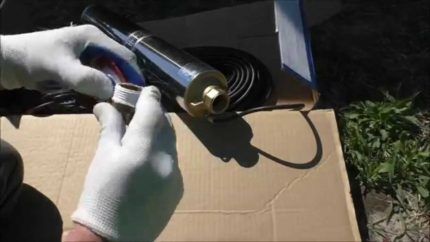
Another risk factor is the level of quality of drilling work. If an experienced team drilled, the well will better withstand the destructive effects. And for wells created with your own hands or through the efforts of “shabashniks”, it is recommended to use not just a centrifugal pump, but special models for wells.
Such devices better withstand the loads associated with pumping water heavily contaminated with sand, silt, clay particles, etc. Another important point is the diameter of the pump. It must match the dimensions of the casing pipe. It is also important to take into account the power supply features of the pump. For wells, both single-phase and three-phase devices are used.
It is easier to find equipment for four-inch pipes than for three-inch pipes. It would be good if this point was taken into account at the well planning stage. The greater the distance from the pipe walls to the pump housing, the better. If the pump fits into the pipe with difficulty rather than freely, you need to look for a model with a smaller diameter.
Read more about choosing a pump in the article How to choose a pump for a well: recommendations for choosing pumping equipment.
Preparation of materials accompanying installation
A stuck pump in a casing can be a major headache. And you need to pull it out (as well as lower it) using a special cable.If the pump is already equipped with a polymer cord, you need to make sure that it is of high quality and of sufficient length. Sometimes it makes more sense to purchase this item separately.
It is believed that a reliable cable or cord must be designed to withstand a load that is at least five times the weight of the equipment attached to it. Of course, it must withstand moisture well, since part of it will constantly be in water.
If the device is suspended relatively shallowly, less than ten meters from the surface, care must be taken to provide additional shock absorption for the equipment during operation. To do this, use a piece of flexible rubber or a medical tourniquet. Metal cable or wire is not suitable for suspension as it does not dampen vibration but may destroy the mount.
A special electrical cable is provided to power the pump. Its length should be sufficient so that the cable lies freely and is not strained.
To supply water from the pump to the house water supply, special plastic pipes are used. Designs with a diameter of 32 mm or larger are recommended. Otherwise, the water pressure in the system will be insufficient.

Pipes can be used both metal and plastic. There is controversy regarding the connection of metal pipes. Some experts object to the threaded connection as less reliable. It is recommended to use flanges, and the bolt should be on top, this will prevent it from accidentally falling into the well.
But threaded connections in wells are used quite successfully. During installation, winding must be used. Some experts recommend using linen or “Tangit” sealing tape instead of the usual FUM tape or tow. The linen winding is additionally strengthened with silicone sealant or similar material.
The characteristics of the water supply pipe should be selected in accordance with its operating conditions. For depths up to 50 meters, HDPE pipes designed for a pressure of 10 atm are used. For a depth of 50-80 m, you will need pipes capable of operating under a pressure of 12.5 atm, and for deeper wells, pipes of 16 atm are used.
In addition to the pump, pipes and cord or rope before installing submersible pump into a well, it is recommended to stock up on the following materials:
- clamps for securing the electrical cable to the pipe;
- check valve;
- pressure gauge;
- shut-off valve for the water pipe;
- steel fastening unit;
- power cable, etc.
Before connecting the pipe to the pump, attach a nipple adapter to its outlet. Usually modern submersible pumps are equipped with such a device, but if it is not there, this unit must be purchased separately.
It should be remembered that to pump the well immediately after drilling, i.e. To remove large amounts of very dirty water from a well, such a pump cannot be used. It will quickly fail. Usually the well is pumped with a separate pump, which is cheaper and works better when working with dirty water.
Rules for installing the surface version
Surface pumps are not often used for this type of water supply as they are only suitable for shallow hydraulic structures, up to eight meters deep.
And yet, this option has a right to exist, and its installation is no more complicated than installing submersible equipment.
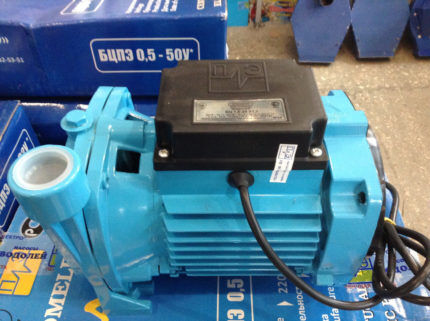
Mount the device as follows:
- The surface pump is installed in a special caisson or a separate room.
- A hose of suitable length is connected to the suction pipe of the pump.
- A check valve is attached to the other end of the hose (a protective measure to prevent water from draining when the pump stops running).
- A protective strainer is installed on the valve to prevent various contaminants from entering the pump housing.
- The hose is lowered into the well.
At this point, the installation can be considered complete and a test run of the pump can be done. To install such a pump in a well, a special adapter is often used. In this case, the hose is connected to the adapter, and the adapter is connected to the pump. The rest of the installation procedure is exactly the same.
It is a little more difficult to install a surface pump equipped with a remote ejector into a well. In this case, two hoses need to be lowered into the well. In addition to the suction hose, a pressure hose is also installed. It is connected to the side fitting of the ejector using a special outlet.
Except check valve and the filter, an ejector must also be installed at the end of the suction hose. It should be remembered that surface pumps are very sensitive to contaminants in the water supplied from the well.
Installation of a submersible pump
Submersible pumps are installed directly in the well. For them, unlike surface models, there is no need to equip a caisson or a separate room.
First, the pump is assembled and performed, i.e. connect a water supply pipe, electrical cable, cord or cable, etc. to it. After this, the pump is lowered into the well.
Step 1. Preparation for equipment installation
A check valve is attached to the pump nozzle so that when it is turned off, water remains in the device. Then a special bowl-shaped filter is installed, designed to filter small particles of sludge. A pipe or discharge hose is installed behind the check valve.
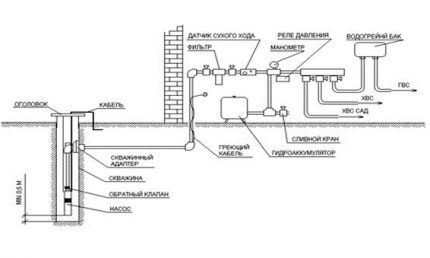
A check valve is necessary to ensure that water remains in the water supply system even after the pump is turned off. This situation can lead to complete equipment failure. The cup-shaped filter protects the working chamber of the pump from silting.
Sometimes a check valve is already provided by the manufacturer and is part of the design. In this case, an additional valve will not be needed.
In some models, it is recommended to use not plastic pipes, but a special rubber hose to supply water. In any case, before starting work, you should carefully study the technical data sheet of the product, as well as the installation instructions provided by the manufacturer.
When installing a water supply pipe, it is important to ensure that it is as level as possible. The fewer obstacles to immersing the structure into a narrow casing, the better. The pipe is then connected to the corresponding pump connection.
Another important point is waterproofing all connections. In addition to heat-shrinkable tubes, special couplings are additionally used at the electrical cable connection points. The power cable also needs to be carefully straightened, aligned and laid along the water pipe.
After the water supply pipe and cable are connected, proceed with the installation of a cable (cord, rope) that will hold the device at the required depth. The stainless steel cable is threaded through the eyes provided for this purpose and secured using a special device. Then the cable is also laid out exactly next to the cable and pipe.
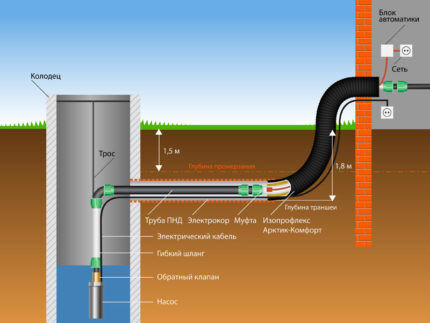
Now you should take fixing clamps or special clips and carefully connect the cable, electrical cable and pipe with them. The connection should be fairly tight, but not overly rigid. If the clamp presses too hard on these structures, it can damage them.
Step #2. Immersion of the pump into the well
When all structures are connected, preparation can be considered complete. You can begin installing the pump in the well.
First, a special rubber gasket is put on the casing pipe and the head is installed. Then the pump is carefully passed into the hole in the head and begins to be smoothly lowered down.
Before you drop submersible pump into the well, a special protective ring can be put on its body so as not to damage the walls of the casing pipe. You can do without this measure, but you will have to act extremely carefully and carefully. The movement of the structure should be very smooth, although its weight is not that small.
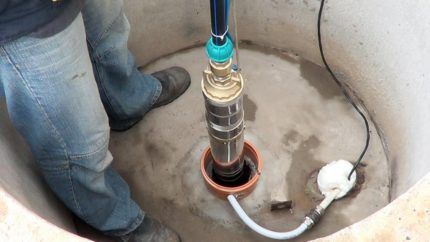
Usually at least three people do this. Two people hold the pump suspended, and the third one gradually releases the cable.
The pump is lowered very slowly. Under no circumstances should you pull the device by the pipe or power cable. If the structure encounters obstacles during lowering, you should proceed very carefully.
You need to stop the pump and make several gentle rotations in both directions. This usually helps you get past a difficult area.As a last resort, if this does not help, you will have to remove the pump and check the condition of the casing.
This check is best done before installing the pump. And during the work, you need to carefully ensure that foreign objects do not accidentally fall into the well, which could interfere with the free movement of the unit. The clearance between the pipe walls and the pump is so small that even an ordinary nut can create a lot of problems.
The pump must be fixed at the correct height, below the dynamic level, so that the device is always completely in the water. But the pump should not be located too close to the bottom water well. This can lead to the pump being sucked into silt or sand when the well is silted or sanded.
It is also necessary to take into account the depth at which the specific pump model is designed to operate. Conventional pumps, as a rule, are lowered to a depth of -10 meters, ejector pumps - to 15-20 meters, special equipment is designed for 25-40 meters.
Typically, the correct pump depth is approximately one to two meters from the bottom of the well, depending on its characteristics. The cable is then secured to a bracket provided for this purpose. It is usually located on the outside of the well cap.
The water supply pipe is connected to home plumbing system, for example, to a storage tank or to a special adapter. Connect the power supply and check the operation of the system. When installing a protective device, the correct current value must be selected.
If this moment is missed, the device may overheat. As a result, the stator winding often shorts. Sometimes there are surges in the voltage supplied to the motor, or it constantly remains too low. All these situations are fraught with rapid breakdown of the device; in some cases, the pump will simply have to be completely replaced.
Step #3. Determining the pump operating point
During pump installation, another important step must be taken - to determine the operating characteristics of the pump under real load. The information specified in the device passport may in fact be very far from what was expected. It is necessary to measure the filling rate of a specific volume, i.e. calculate water consumption per unit of time.
In addition, you should use a pressure gauge to determine the pressure that is created in the water supply when the pump is operating. You will also need to measure the current consumption during operation of the device. To do this, special conductive forceps are attached to it.
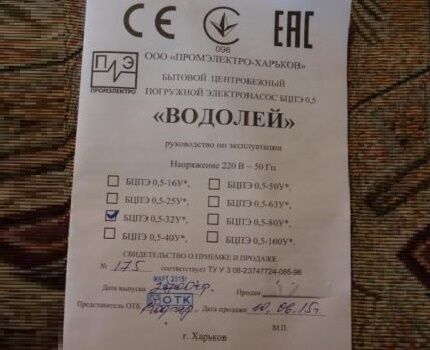
Once the necessary measurements have been made, they should be compared with the manufacturer's data specified in the technical documentation of the product. If it turns out that the actual values exceed those recommended by the manufacturer, you should slightly close the pump valve.
As a result, additional resistance will be created, which will bring the device parameters back to normal. In this way, the operating point of the device is verified and established under different operating modes.
Some important recommendations
A special brass fitting is used to connect the check valve to the water supply pipe. The connection must also have a special drive sleeve. This measure will prevent the pipe from shrinking in diameter and will compensate for the excess stress created by the compression fitting.
The fitting, like all connecting elements, must be of high quality, designed for increased tensile loads. Otherwise, the pipe may simply jump out of the fitting. To connect the opposite end of the HDPE pipe with the outlet at the head, use the same compression drive-in fitting made of brass.
A special electrical cable for submersible pumps is available for sale. It is this that must be used to connect to the pump. Substitutions with lower quality materials are not acceptable. The power cable is connected to the pump cable by soldering; it is better not to use twisting in such an important place. The connection point is covered with a heat-shrink sleeve.
To secure the cable and cable to the water supply pipe, you need plastic clamps. They are installed every 2-3 meters.This measure helps to avoid accidental tangling of the cable while lowering the structure down. Instead of clamps, you can use electrical tape.
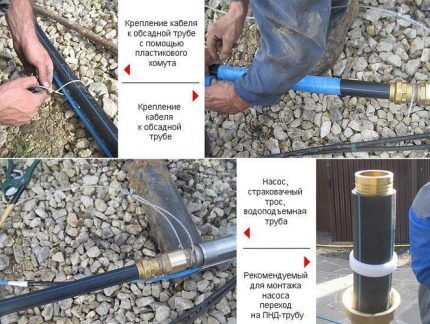
For the sake of economy, a special cable is used only in the area where it will be immersed in water. The remaining distance is covered by a regular PVS cable.
In any case, the cable cross-section must comply with the manufacturer’s recommendations specified in the pump data sheet.

The pump can only be suspended from a stainless steel cable. Neither regular black steel nor its galvanized version are designed to withstand continuous use in water.
When lowering the pump in narrow areas, you can supplement the rotation of the pump with a small amount of pressure. But in any case, the pump must maintain a vertical position.
During pump installation well head may move a little. You should make sure that the weight of the pump rests on the cable and is not supported by the pipe. Only after this the position of the head can be fixed with screws.
Conclusions and useful video on the topic
Video #1. Practical advice on choosing and installing a submersible pump is contained in the following video:
Video #2. A visual demonstration of another pump installation experience:
It is very important to carry out all operations for installing pumping equipment in a well correctly, since any negligence can result in breakdown or breakage of the cable.
There are situations when damaged the pump is impossible to get from the workings. This leads to a complete loss of the structure and makes it necessary to start drilling all over again. Care and attention will help you install the pump in the best possible way.
You can share your own experience gained in the process of installing a deep-well pump or connecting a pumping station, ask questions, and report any shortcomings in the text in the block below. Please write comments. We and site visitors will be happy to participate in discussions to clarify controversial issues.




Typically, the technical specifications indicate the suction depth, indicating the maximum depth from which the unit is capable of pumping water, and the pressure value, indicating the highest height to which it can deliver water. The passports for submersible pumps must indicate the immersion depth, i.e. the distance from the water surface to the top of the unit, and also the distance from the bottom of the pump to the bottom of the excavation.
The technical characteristics of the pumps make it possible to select a machine for pumping water taking into account the depth of immersion, as well as buy it with the required performance.
Also, for installation in sources with low flow rates, it is important that the pump has a safety device that turns off the engine if the water level in the well decreases.
I drilled a well, everything went smoothly, but I ran into the problem of installing a pump in it. I was afraid of somehow breaking the pump by lowering it into the barrel incorrectly.
I talked to friends who also installed a pump in a well, but it turned out that they all paid for professional craftsmen.I started looking for information on the Internet, and here, in principle, everything was explained clearly, there were, of course, a few unclear things, but I dealt with them myself. In general, the information is useful!
Tell me, those who know. The question for me is urgent and very important: the load from the weight of the pump and the water-lifting pipe with water should fall on: 1 - mounting cable; 2 - water-lifting pipe or 3 - on a special mounting mount?
Please tell me, is it possible to lower the pump below the casing?